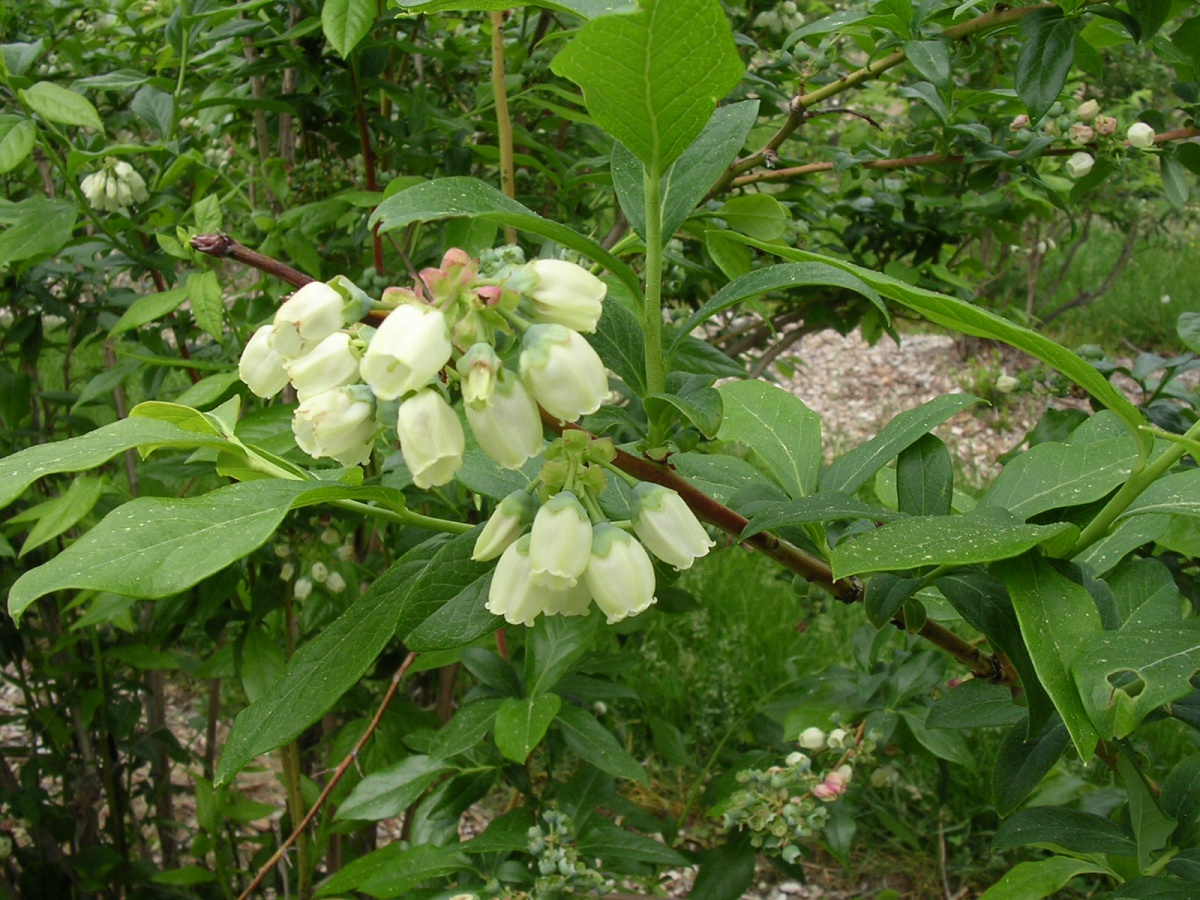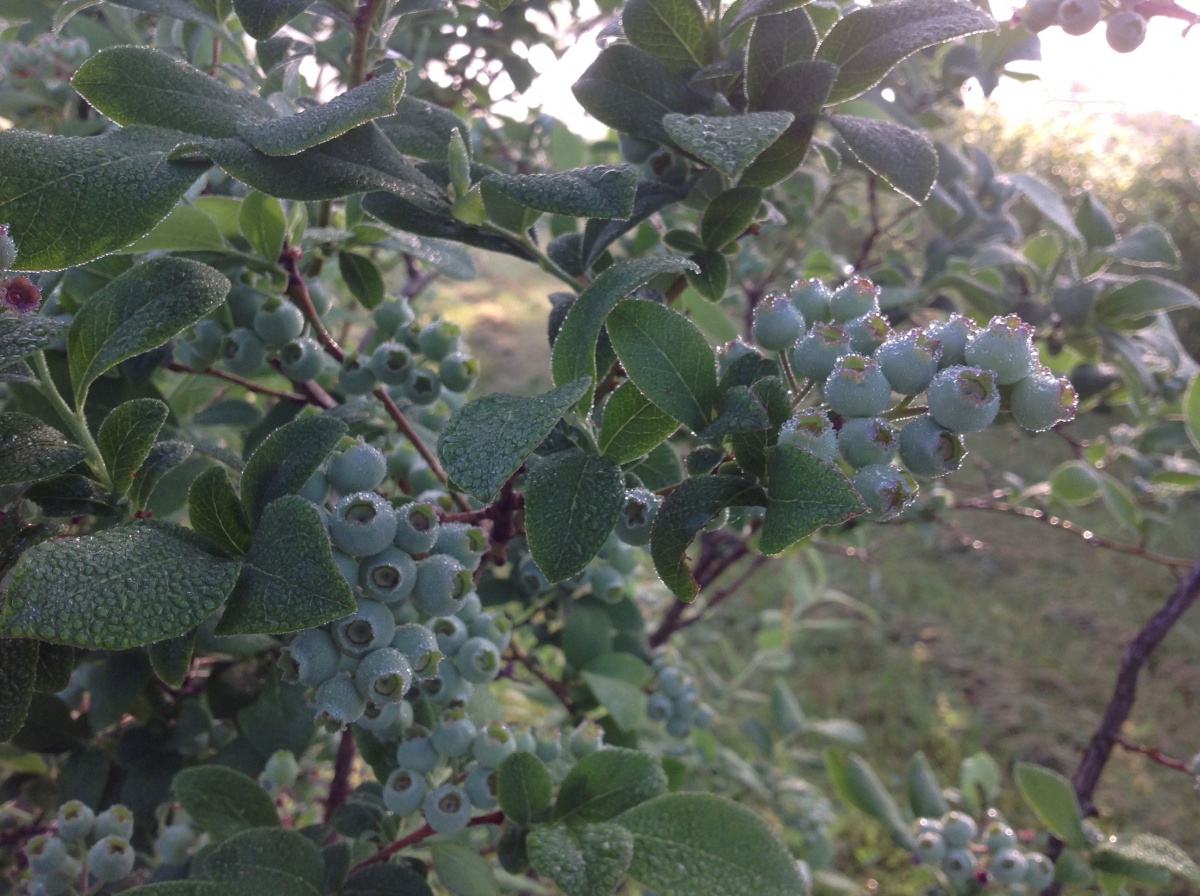Highbush blueberries are a popular home garden fruit for both fresh and frozen use. They grow well throughout the southern half of New Hampshire and satisfactorily on warmer sites in northern New Hampshire where the planting is protected from prevailing winds and winter temperatures rarely fall below -25oF.
Site and Soils
Blueberries grow best in a well-drained sandy loam, rich in organic matter. Clay soils can be made suitable for blueberries by adding organic matter (such as peat moss) and sand. In very poorly drained soils, blueberries may be planted in ridges 4 inches above the surrounding soil level. Full sunlight all day long is essential for maximum production. Blueberries require an acidic soil with a pH range of 4.5 to 5.0. Abandoned pastures and fields and woodland soils generally have a pH suitable for blueberry growth, although only a soil test will determine the actual pH level. Soil can be tested though UNH Cooperative Extension or a number of other laboratories. To obtain information about UNHCE soil testing services, phone (603) 862-3200, visit: www.extension.unh.edu/Problem-Diagnosis-and-Testing-Services/Soil-Testing or email soil.testing@unh.edu. If the soil pH is above 5.0, apply finely ground sulfur at the recommended rate. Do no ot apply sulfur except as directed by a soil test recommendation.
Planting
Highbush blueberries are normally planted at least 5 feet apart in rows 8 to 10 feet apart. Set healthy 2 or 3-year old plants in early spring. Dig a planting hole at least twice as large as the blueberry plant root system. Backfill with good topsoil and a small amount of thoroughly moistened peat moss. Do not put any fertilize in the planting hole. Set the plant slightly deeper than it was set in the nursery and water thoroughly. Take care that the blueberry roots do not dry out during the transplanting process. Prune out weak and broken branches.

Care
Remove all blossoms that appear the year the plants are established (second year blossom removal is also desirable) to encourage plant growth. Blueberries have a shallow root system and should be mulched with a layer of organic mulch 3 to 4 inches deep. Wood chips, bark, pine needles, leaves, or combinations of these all make good mulch. Moisten soil before applying mulch. Supply plants with a uniform and adequate water supply as needed from blossom time through harvest and control both perennial and annual weeds. Making sure that plants have adequate water is especially important during the establishment year. Three to four weeks after planting, apply 1½ ounces 10-10-10 fertilizer or its equivalent (see Table 1). Apply fertilizer in a circle 15 to 18 inches from the plant. For established bushes, apply fertilizers at bloom time, or apply half at bloom, and half 3-4 weeks later. Do not apply fertilizers after July 1, to avoid stimulating late season growth that is susceptible to winter injury. In future years increase this fertilizer according to Table 1.
Table 1: Ounces of Fertilizer Per Plant

Pruning
During the first 2 or 3 years blueberries require little pruning except to remove dead, diseased or weak branches. After the third year, prune plants annually in early spring, while they are still dormant. Fruit is produced on vigorous, one-year-old wood. First remove all dead, broken, or diseased wood and branches close to the ground. Remove at ground level any old, weak stems no longer producing strong one-year-old wood. Keep 6 to 7 vigorous older stems and 1 or 2 strong new shoots per bush. The new shoots will eventually replace older stems. To learn more, call your local UNH Extension office to find out how you can attend a pruning demonstration near you, or you can watch this excellent video produced by the University of Maine, ‘How to prune a blueberry bush’.
Harvesting
Blueberries begin to ripen in early to mid-July in New Hampshire and reach peak production during early August. Fruit is produced in clusters of 5 to 10 berries, which ripen in succession over a period of several weeks. Pick only fully ripe berries and harvest all of the ripe fruit on the bush. Blueberries often turn blue with a slight reddish tinge several days before they are fully ripe. Delaying harvest until berries are fully ripe will result in better tasting, larger fruit and increased total yields.

Pest Management
Pests can sometimes be serious problems. The most common blueberry pests are listed below, along with links to additional information on how to manage them. Birds frequently eat unprotected fruit. Netting (available from garden supply dealers) is the most effective method of control. Usually a permanent post and wire frame is built to hold the netting in place up off the plants. Apply netting as soon as the first fruits turn blue; remove and put in storage as soon as the harvest is complete. For more information, please see the UNH Publication ‘Bird Damage Prevention for Northern New England Fruit Growers’.
Spotted wing drosophila (tiny flies) attack fruit, especially later maturing varieties. Harvesting fruits as soon as they ripen, and refrigerating or freezing fruit right away, can reduce the damage caused by these pests. To keep the flies from infesting fruits, it is important to monitor the insects with traps. You can find more information about this pest at our ‘UNH Extension Spotted Wing Drosophila’ page.
Blueberry fruit fly sometimes builds up to high levels. It is easy to monitor for this pest using traps, so that you can confirm whether or not you have this pest. For more information, please see the UNH Publication ‘Using traps to monitor blueberry fruit fly in New Hampshire’. Mummyberry, a disease caused by a fungus, can be damaging if we have a rainy spring. The Ohio State University fact sheet, ‘Mummyberry of Blueberry’, is an excellent resource. For additional information on how to manage specific insect and disease pest problems, call the UNH Cooperative Extension Info Line, 1-877-398- 4769 or 1-877-EXT-GROW.
Varieties
Patriot - Large fruit. High productivity. Hardy, excellent flavor.
Blueray - Large fruit. High productivity. Excellent fruit size and flavor.
Bluecrop - Large, powder blue, firm berries. Moderate productivity. Will not tolerate wet soils.
Jersey - Medium to large fruit. Good quality, late summer berry.
The following highbush x lowbush blueberry varieties should be hardy throughout the state including Coos County. They will perform best when snow cover is good. In addition to fruit production, these cultivars are well adapted for ornamental use.
Northland - Medium sized fruit. Very productive. 5 ft. tall.
North Country - Medium sized fruit, sweet. Moderately productive. 2 ft. tall.
Northblue - Large fruit, good quality. Moderately productive. 2½ ft. tall.
St. Cloud - Large fruit. Moderately productive. 4 ft. tall.
Friendship - Medium to small fruit. Moderately productive. 2 ft. tall

Download the Resource for the complete fact sheet.
